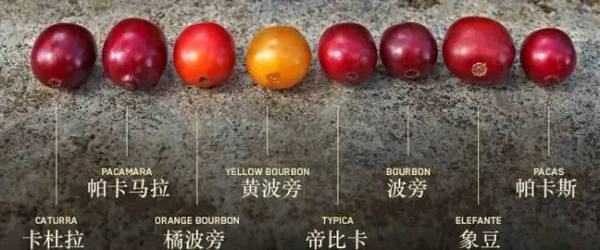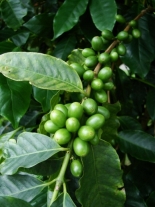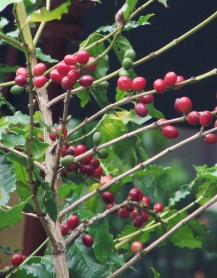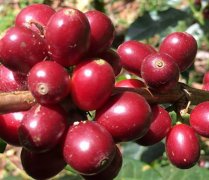The evolution of coffee. Growing environment and common coffee varieties

For professional baristas, please follow the coffee workshop (Wechat official account cafe_style)
The evolution of coffee
At first, the use of coffee was to mash the fruit and stir the oil to make balls to eat, and then gradually evolved to boil the fruit and leaves together into juice to drink. As now, coffee beans were fried and ground into powder for use in the 13th century; coffee became a local drink in the Muslim holy land of Mecca in the 15th century and spread throughout the Muslim world through pilgrims from all over the world. With the prosperity of Muslim countries in the mid-17th century, businessmen and travelers from Europe introduced coffee into Europe and were regarded as treasures for banquets. At the end of the 17th century, coffee began to spread to every corner of the world with European civilization, including the American continent.
The growing environment of coffee

Coffee is the fruit of a Rubiaceae plant, produced between the Tropic of Cancer and the Tropic of Cancer, with an average annual temperature of 22-25 ℃ (also known as the coffee belt). It is suitable for growing in frost-free places with little temperature difference throughout the year, fertile gravel, sandy soil, volcanic rock, earth and stone. It is mostly located in high-altitude plateaus or slopes, and its height is mostly trimmed into white flowers with 5 or 6 petals of 2 to 3 meters. The fruit changes from green to bright red as it ripens, just like a cherry.

The structure of coffee

The fruit of a coffee tree, its structure in the outermost layer is the peel, under the pericarp is the pulp, and below the pulp is a layer of bean shell wrapped with beans; and in a fruit with two beans, we call it flat beans and some people call it (mother beans), this is quite common; and if there is only one bean kernel in a fruit, we call it pill beans or round beans peaberry and some people call it (public beans).
Common varieties of coffee at present
Elaraby plus seed (ARABICA): this is the earliest discovered variety, developed from Ethiopia, less tolerant to low temperature and drought, larger particles, good quality, mellow flavor, containing varying degrees of acidity, accounting for about 85% of the world's output, and is now the most important variety in the world. The main producing areas are: countries in Central and South America, Brazil, Colombia, Ethiopia in Africa, Tanzania, Yemen in the Arabian Peninsula, Indonesia and other places.
Romda species (ROBUSDA): discovered in the Congo more than two thousand years ago, characterized by high temperature resistance, drought resistance, stout, round and small particles, slightly bitter and cold taste still has a fragrance, accounting for about 15% of the world's output of the main producing areas are: Indonesia's Java, Congo, Uganda, C ô te d'Ivoire and other places.
Liberia plus species (LIBERICA): first found in Libya, beans are long, large particles, slightly pointed head, shaped like a boat, but poor quality, too acidic, rarely to drink, but its trunk tall and strong disease resistance can be used for variety improvement.
Important Notice :
前街咖啡 FrontStreet Coffee has moved to new addredd:
FrontStreet Coffee Address: 315,Donghua East Road,GuangZhou
Tel:020 38364473
- Prev

What is the value of boutique coffee when we can't drink it?
For professional baristas, please follow the coffee workshop (Wechat official account cafe_style). I have a friend who makes tea. He is now committed to promoting Taiwan tea to Europe and Russia. In 1993, when I followed some colleagues in the coffee industry to visit the Food and Beverage equipment Exhibition in Tokyo, Japan, I knew this friend because I lived in the same room all the time. I called him [master]. The master was [
- Next

The main ingredient of coffee. Introduction to the processing process and the baking degree of coffee beans
Professional baristas please pay attention to coffee workshop (Wechat official account cafe_style) the main ingredients of coffee include caffeine, minerals, tannins, sugar, moisture, fat, protein, fiber, among which caffeine, tannins and sugar are the main elements to form coffee flavor. Caffeine also stimulates our cerebral cortex to refresh our minds.
Related
- Beginners will see the "Coffee pull flower" guide!
- What is the difference between ice blog purified milk and ordinary milk coffee?
- Why is the Philippines the largest producer of crops in Liberia?
- For coffee extraction, should the fine powder be retained?
- How does extracted espresso fill pressed powder? How much strength does it take to press the powder?
- How to make jasmine cold extract coffee? Is the jasmine + latte good?
- Will this little toy really make the coffee taste better? How does Lily Drip affect coffee extraction?
- Will the action of slapping the filter cup also affect coffee extraction?
- What's the difference between powder-to-water ratio and powder-to-liquid ratio?
- What is the Ethiopian local species? What does it have to do with Heirloom native species?

